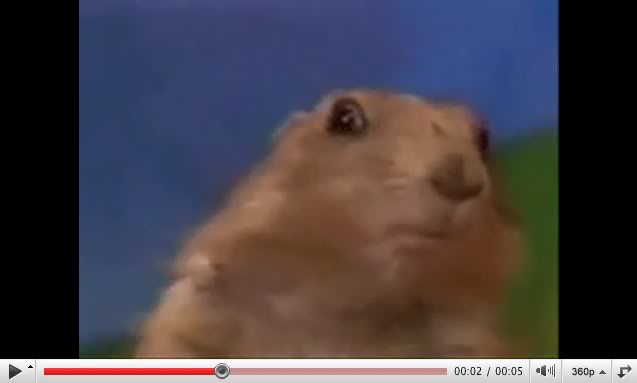CPS353: Internet Programming
Course Introduction, Foundations of the Internet, and HTML
Marcos Elugardo
Gordon College
Last Modified: 08/26/2015
Selected content adapted from material by Simon Minor, Marty Stepp, Jessica Miller, and Victoria Kirst © 2012. Used by permission.
Agenda
- Introductions
- Course Syllabus
- The Internet and WWW
- HTML
- Homework 1
Introductions
- Who are you? (name, background, class, major, minors)
- Do you have any experience in web programming?
- What did you do this summer?
- How is God working in your life right now?
- What's one interesting thing about you that nobody in the room knows?
Course Syllabus
1.1: The Internet
- 1.1: The Internet
- 1.2: The World Wide Web (WWW)
The Internet
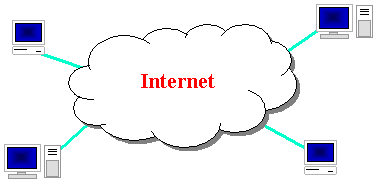
- Wikipedia: http://en.wikipedia.org/wiki/Internet
- a connection of computer networks using the Internet Protocol (IP)
- layers of communication protocols: IP → TCP/UDP → HTTP/FTP/POP/SMTP/SSH...
- What's the difference between the Internet and the World Wide Web (WWW)?
- the Web is the collection of web sites and pages around the world; the Internet is larger and also includes other services such as email, chat, online games, etc.
Brief history
- began as a US Department of Defense network called ARPANET (1960s-70s)
- initial services: electronic mail, file transfer
- opened to commercial interests in late 80s
- WWW created in 1989-91 by Tim Berners-Lee
- popular web browsers released: Netscape 1994, IE 1995
- Amazon.com opens in 1995; Google January 1996
- Hamster Dance web page created in 1999
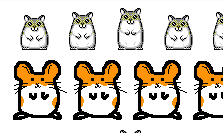
- Wikipedia launches 2001, MySpace in 2003, Facebook in 2004
Key aspects of the internet
- subnetworks can stand on their own
- computers can dynamically join and leave the network
- built on open standards; anyone can create a new internet device
- lack of centralized control (mostly)
- everyone can use it with simple, commonly available software
People and organizations
- Internet Engineering Task Force (IETF): internet protocol standards
- Internet Corporation for Assigned Names and Numbers (ICANN):
decides top-level domain names - World Wide Web Consortium (W3C): web standards
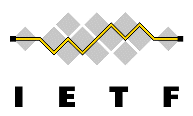


Internet Protocol (IP)
- a simple protocol for attempting to send data between two computers
- each device has a 32-bit IP address written as four 8-bit numbers (0-255)

- find out your internet IP address: whatismyip.com
- find out your local IP address:
- in a terminal, type:
ipconfig(Windows) orifconfig(Mac/Linux)
- in a terminal, type:
IPv6
Transmission Control Protocol (TCP)
- adds multiplexing, guaranteed message delivery on top of IP
-
multiplexing: multiple programs using the same IP address
- port: a number given to each program or service
- port 80: web browser (port 443 for secure browsing)
- port 25: email
- port 22: ssh
- port 5190: AOL Instant Messenger
- more common ports
- IP + TCP = TCP/IP
- some programs (games, streaming media programs) use simpler UDP protocol instead of TCP
1.2: The World Wide Web (WWW)
- 1.1: The Internet
- 1.2: The World Wide Web (WWW)
Web servers and browsers

-
web server: software that listens for web page requests
- Apache
- Microsoft Internet Information Server (IIS) (part of Windows)
- nginx and lighttpd -- Lighter weight open source alternatives to Apache
- web browser: fetches/displays documents from web servers
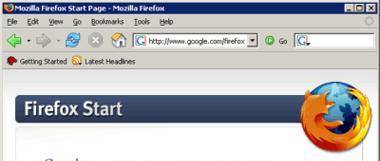
- Mozilla Firefox
- Microsoft Internet Explorer (IE)
- Apple Safari
- Google Chrome
- Opera
Domain Name System (DNS)
- a set of servers that map written names to IP addresses
- because names are easier to remember than IP addresses
- Example:
www.cps.gordon.edu→216.236.251.139
- many systems maintain a local cache called a hosts file (looking up domain names is expensive)
- Windows:
C:\Windows\system32\drivers\etc\hosts - Mac:
/private/etc/hosts - Linux:
/etc/hosts
- Windows:
Uniform Resource Locator (URL)
- an identifier for the location of a document on a web site
-
a basic URL:
http://www.aw-bc.com/info/regesstepp/index.html ~~~~ ~~~~~~~~~~~~~ ~~~~~~~~~~~~~~~~~~~~~~~~~~ protocol host path
-
upon entering this URL into the browser, it would:
- ask the DNS server for the IP address of
www.aw-bc.com - connect to that IP address at port 80
- ask the server to
GET /info/regesstepp/index.html - display the resulting page on the screen
- ask the DNS server for the IP address of
More URL components
-
anchor: jumps to a given section of a web page
http://www.textpad.com/download/index.html#downloads
- fetches
index.htmlthen jumps down to part of the page labeleddownloads
- fetches
-
port: for web servers on ports other than the default 80
http://www.cps.gordon..edu:8080/secret/money.txt
-
query string: a set of parameters passed to a web program
http://www.google.com/search?q=miserable+failure&start=10
- parameter
qis set to"miserable+failure" - parameter
startis set to10
- parameter
Hypertext Transport Protocol (HTTP)
- the set of commands understood by a web server and sent from a browser
-
some HTTP commands (your browser sends these internally):
GET filename: downloadPOST filename: send a web form responsePUT filename: upload
-
simulating a browser with a terminal window:
$ telnet www.cps.gordon.edu 80 Trying 216.236.251.139... Connected to www.cps.gordon.edu. Escape character is '^]'. GET /index.html <!DOCTYPE HTML PUBLIC "-//W3C//DTD HTML 4.01 Transitional//EN"> <html> ...
HTTP error codes
- when something goes wrong, the web server returns a special "error code" number to the browser, possibly followed by an HTML document
- common error codes:
Number Meaning 200 OK 301-303 page has moved (permanently or temporarily) 403 you are forbidden to access this page 404 page not found 500 internal server error complete list
Internet media ("MIME") types
-
sometimes when including resources in a page (style sheet, icon, multimedia object), we specify their type of data
MIME type file extension text/html .html text/plain .txt image/gif .gif image/jpeg .jpg video/quicktime .mov application/octet-stream .exe application/json .json application/xml .xml - Lists of MIME types: by type, by extension
Web languages / technologies
- Hypertext Markup Language (HTML): used for writing web pages
- Cascading Style Sheets (CSS): stylistic info for web pages
- PHP Hypertext Processor (PHP): dynamically create pages on a web server
- JavaScript: interactive and programmable web pages (with libraries like jQuery)
- Asynchronous JavaScript and XML (Ajax): retrieving data for web applications from pre-loaded web pages
- eXtensible Markup Language (XML) and JavaScript Obejct Notation (JSON): meta-languages for organizing data
- Ruby on Rails: web application development framework
- C#: a Microsoft .net language used in web development as well as in other contexts
2.1: Basic HTML
- 2.1: Basic HTML
- 2.2: More HTML Elements
- 2.3: Web Standards
Hypertext Markup Language (HTML)
- describes the content and structure of information on a web page
- not the same as the presentation (appearance on screen)
- surrounds text content with opening and closing tags
- each tag's name is called an element
- syntax:
<element>content</element> - example:
<p>This is a paragraph</p>
- syntax:
- whitespace is frequently insignificant in HTML (ignored or collapsed to a single space)
Structure of an HTML page
<!DOCTYPE html> <html> <head> information about the page </head> <body> page contents </body> </html>
- the header describes the page and the body contains the page's contents
- an HTML page is saved into a file ending with extension
.htmlor.htm DOCTYPEtag tells browser to interpret our page's code as HTML
Page title: <title>
describes the title of the web page
<title>Chapter 2: HTML Basics</title>
- placed within the
headof the page - displayed in the web browser's title bar and when bookmarking the page
Paragraph:
<p>
paragraphs of text (block)
<p>In the beginning was the Word,
and the Word was with God,
and the Word was God.
He was with God in the beginning.
</p>
In the beginning was the Word, and the Word was with God, and the Word was God. He was with God in the beginning.
- placed within the
bodyof the page - more paragraph examples
Headings:
<h1>,
<h2>, ...,
<h6>
headings to separate major areas of the page (block)
<h1>University of Whoville</h1> <h2>Department of Computer Science</h2> <h3>Sponsored by Micro$oft</h3>
University of Whoville
Department of Computer Science
Sponsored by Micro$oft
Horizontal rule:
<hr>
a horizontal line to visually separate sections of a page (block)
<p>First paragraph</p> <hr /> <p>Second paragraph</p>
First paragraph
Second paragraph
- should be immediately closed with
/>
More about HTML tags
- some tags can contain additional information called attributes
- syntax:
<element attribute="value"attribute="value">content</element> - example:
<a href="page2.html">Next page</a>
- syntax:
- some tags don't contain content; can be opened and closed in one tag
- syntax:
<element attribute="value"attribute="value" /> - example:
<hr /> - example:
<img src="bunny.jpg" alt="pic from Easter" />
- syntax:
Links:
<a>
links, or "anchors", to other pages (inline)
<p> Search <a href="http://www.google.com/">Google</a> or our <a href="01_course_introduction.html">Lecture Notes</a>. </p>
Search Google or our Lecture Notes.
- uses the
hrefattribute to specify the destination URL- can be absolute (to another web site) or relative (to another page on this site)
- anchors are inline elements; must be placed in a block element such as
porh1
Block and inline elements

- block elements contain an entire large region of content
- examples: paragraphs, lists, table cells
- the browser places a margin of whitespace between block elements for separation
- inline elements affect a small amount of content
- examples: bold text, code fragments, images
- the browser allows many inline elements to appear on the same line
- must be nested inside a block element
Images:
<img>
inserts a graphical image into the page (inline)
<img src="images/gollum.jpg" alt="Gollum from LOTR" />

- the
srcattribute specifies the image URL - HTML5 also requires an
altattribute describing the image
More about images
<a href="http://theonering.net/"> <img src="images/gandalf.jpg" alt="Gandalf from LOTR" title="You shall not pass!" /> </a>
- if placed in an
aanchor, the image becomes a link titleattribute is an optional tooltip (on ANY element)
Line break:
<br>
forces a line break in the middle of a block element (inline)
<p>The Lord is my shepherd, I lack nothing.<br /> He makes me lie down in green pastures,<br /> he leads me beside quiet waters,<p>
The Lord is my shepherd, I lack nothing.
He makes me
ie down in green pastures,
he leads me beside quiet waters,
-
Warning: Don't over-use
brthey are hard to apply css styles (more on this later)
brshould not be used to separate paragraphs or used multiple times in a row to create spacing
Phrase elements
:
<em>, <strong>
em: emphasized text (usually rendered in italic)
strong: strongly emphasized text (usually rendered in bold)
<p> HTML is <em>really</em>, <strong>REALLY</strong> fun! </p>
HTML is really REALLY fun!
- as usual, the tags must be properly nested for a valid page
Nesting tags
<p> HTML is <em>really, <strong>REALLY</em> lots of</strong> fun! </p>
- tags must be correctly nested
- (a closing tag must match the most recently opened tag)
- the browser may render it correctly anyway, but it is invalid HTML
- (how would we get the above effect in a valid way?)
Comments: <!-- ... -->
comments to document your HTML file or "comment out" text
<!-- My web page, by Anthony Aardvark CPS353 Fall 2015 --> <p>Computer science courses are <!-- NOT --> a lot of fun!</p>
Computer science courses are a lot of fun!
- many web pages are not thoroughly commented (or at all)
- still useful at top of page and for disabling code
- comments cannot be nested and cannot contain a
--
2.2: More HTML Elements
- 2.1: Basic HTML
- 2.2: More HTML Elements
- 2.3: Web Standards
Unordered list:
<ul>,
<li>
ul represents a bulleted list of items (block)
li represents a single item within the list (block)
<ul> <li>No shoes</li> <li>No shirt</li> <li>No soup for you!</li> </ul>
- No shoes
- No shirt
- No soup for you!
More about unordered lists
- a list can contain other lists:
<ul> <li>Tribes: <ul> <li>Levi</li> <li>Judah</li> <li>Benjamin</li> </ul> </li> <li>Apostles: <ul> <li>Peter</li> <li>John</li> </ul> </li> </ul>
- Tribes:
- Levi
- Judah
- Benjamin
- Disciples:
- Peter
- John
Ordered list: <ol>
ol represents a numbered list of items (block)
<p>RIAA business model:</p> <ol> <li>Sue customers</li> <li>???</li> <li>Profit!</li> </ol>
RIAA business model
- Sue customers
- ???
- Profit!
- we can make lists with letters or Roman numerals using CSS (later)
Definition list:
<dl>, <dt>, <dd>
dl represents a list of definitions of terms (block)
dt represents each term, and dd its definition
<dl> <dt>newbie</dt> <dd>one who does not have mad skills</dd> <dt>own</dt> <dd>to soundly defeat (e.g. I owned that newbie!)</dd> <dt>frag</dt> <dd>a kill in a shooting game</dd> </dl>
- newbie
- one who does not have mad skills
- own
- to soundly defeat (e.g. I owned that newbie!)
- frag
- a kill in a shooting game
Quotations: <blockquote>
a lengthy quotation (block)
<p>As Lincoln said in his famous Gettysburg Address:</p> <blockquote> <p>Fourscore and seven years ago, our fathers brought forth on this continent a new nation, conceived in liberty, and dedicated to the proposition that all men are created equal.</p> </blockquote>
As Lincoln said in his famous Gettysburg Address:
Fourscore and seven years ago, our fathers brought forth on this continent a new nation, conceived in liberty, and dedicated to the proposition that all men are created equal.
Inline quotations: <q>
a short quotation (inline)
<p>Quoth the Raven, <q>Nevermore.</q></p>
Quoth the Raven, Nevermore.
-
Why not just write the following?
<p>Quoth the Raven, "Nevermore."</p>
We don't use " marks for two reasons:
- HTML shouldn't contain literal quotation mark characters; they should be written as
" - using
<q>allows us to apply CSS styles to quotations (seen later)
HTML Character Entities
a way of representing any Unicode character within a web page
| character(s) | entity |
|---|---|
| < > | < > |
| é è ñ | é è ñ |
| ™ © | ™ © |
| π δ Δ | π δ Δ |
| И | И |
| " & | " & |
- Complete list of HTML entities (How would you display the text
&on a web page?)
HTML-encoding text
<p> <a href="http://google.com/search?q=aardvark&ie=utf-8"> Search Google for Aardvark </a> </p><p> <a href="http://google.com/search?q=aardvark&ie=utf-8"> Search Google for Aardvark </a> </p>
- To display the link text in a web page, its special characters must be encoded as shown above
Computer code:
<code>
a short section of computer code (usually shown in a fixed-width font)
<p> The <code>ul</code> and <code>ol</code> tags make lists. </p>
The ul and ol
tags make lists.
Preformatted text:
<pre>
a large section of pre-formatted text (block)
<pre>
Steve Jobs speaks loudly
reality distortion
Apple fans bow down
</pre>
Steve Jobs speaks loudly
reality distortion
Apple fans bow down
- displayed with exactly the whitespace / line breaks given in the text
- shown in a fixed-width font by default
- how would it look if we had instead enclosed it in
codetags?
Web page metadata:
<meta>
information about your page (for a browser, search engine, etc.)
<meta http-equiv="Content-Type"
content="text/html; charset=iso-8859-1" />
<meta name="description"
content="Authors' web site for Building Java Programs." />
<meta name="keywords" content="java, textbook" />
- placed in the
headsection of your HTML page metatags often have both thenameandcontentattributes- some
metatags use thehttp-equivattribute instead ofname
- some
- using a
metatagContent-Typeexplicitly specifies what kind of content is in the web page- stops validator "tentatively valid" warnings
Favorites icon ("favicon")
<link href="filename" type="MIME type" rel="shortcut icon" />
<link href="yahoo.gif" type="image/gif" rel="shortcut icon" />
- the
linktag, placed in theheadsection, attaches another file to the page- in this case, an icon to be placed in the browser title bar and bookmarks
- IE6: Doesn't work; must put a file
favicon.icoin the root of the web server (info)
HTML tables:
<table>,
<tr>,
<td>
A 2D table of rows and columns of data (block element)
<table> <tr><td>1,1</td><td>1,2 okay</td></tr> <tr><td>2,1 real wide</td><td>2,2</td></tr> </table>
| 1,1 | 1,2 okay |
| 2,1 real wide | 2,2 |
tabledefines the overall table,treach row, andtdeach cell's data- tables are useful for displaying large row/column data sets
- NOTE: tables are sometimes used by novices for web page layout, but this is not proper semantic HTML and should be avoided
Table headers, captions:
<th>,
<caption>
<table> <caption>My important data</caption> <tr><th>Column 1</th><th>Column 2</th></tr> <tr><td>1,1</td><td>1,2 okay</td></tr> <tr><td>2,1 real wide</td><td>2,2</td></tr> </table>
| Column 1 | Column 2 |
|---|---|
| 1,1 | 1,2 okay |
| 2,1 real wide | 2,2 |
thcells in a row are considered headers; by default, they appear bold- a
captionat the start of the table labels its meaning
Class Exercise
2.3: Web Standards
- 2.1: Basic HTML
- 2.2: More HTML Elements
- 2.3: Web Standards
Web Standards
- It is important to write proper HTML code and follow proper syntax.
- Why use valid HTML and web standards?
W3C HTML Validator
<p> <a href="http://validator.w3.org/check/referer"> <img src="http://validator.w3.org/images/valid_icons/valid-xhtml10g" alt="Validate" /> </a> </p>
- validator.w3.org
- checks your HTML code to make sure it follows the official HTML syntax
- more picky than the browser, which may render invalid HTML correctly
What is HTML 5?
-
a new W3C standard version of the HTML markup language

- successor to HTML 4.01 and XHTML 1.1
- balance between too-loose-ness of HTML 4 and too-strict-ness of XHTML
- reduces the browser's need for plugins to display content, e.g. multimedia
- make web content richer, semantically meaningful, descriptive, accessible
- more easily enable the web as an application platform (Web 2.0)
What's new in HTML 5?
What's new, continued
-
semantic web / microdata attributes:
rel="...",itemscope,itemtype,itemprop

-
 accessibility features ("ARIA")
accessibility features ("ARIA")
- embedding of rich XML-like formats such as SVG vector graphics
- other stuff: offline apps, geolocation, cross-document messaging, MIME type registration, history management, ...
File formats
- some differ in features (animation, 5.1 stereo, transparency)
- many multimedia formats use compression to reduce file size
- some formats are patented (unusable in free software)
- some formats are encrypted to protect information inside
- Digital Rights Management (DRM) restricts what user can do with file
- can be broken: DVD (DeCSS), HD DVD (09f911029d74e35bd84156c5635688c0)
- some formats are streaming (can play while downloading)
- comparisons of formats: audio/video containers
Image file formats
- JPEG : uses "lossy compression"; small file size; good for photos
- GIF : 256 colors; LZW run-length encoding lossless compression
- allows transparency (can see behind parts of image)
- possible to create animated GIFs
- PNG : free format created to avoid patent and color issues in GIF format; lossless compression, transparency
- others: TIFF, BMP
- image format comparisons: text, photo, PNG
Raster and vector graphics
- the image formats on the previous slide are raster or bitmap formats
- they describe the pixels that should be drawn on the screen
- vector graphics formats such as SVG describe shapes/lines rather than pixels
- advantage: infinite precision; good for zooming, printing
- disadvantage: not supported on all platforms; computationally expensive
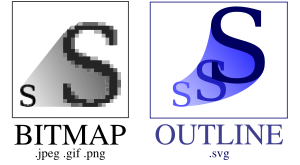
Audio file formats
- MP3 : uses lossy compression that eliminates inaudible sounds
- AAC : Apple's iTunes audio file format
- WMA / ASF: Microsoft Windows Media Audio format
- OGG : Linux hippie audio/video format
- RA / RM / RAM : Real Audio format
- other formats: WAV (MS), AU (Sun), AIFF / SND (Apple), FLAC
- Sequenced Music: MID, MOD
Video file formats
Flash
- format for graphics, video, audio developed by Macromedia/Adobe
- widely used for many reasons:
- supported in most major platforms/browsers
- lightweight
- can produce impressive interactive animated content
- downsides: proprietary; editing software costs money (viewer is free), does not work on Apple's iOS
- examples: Homestar Runner
Linking to multimedia files
<a href="video.avi">My video</a>
- browser has a list of default applications to associate with each file type
- if it has an associated app, it will run it
- some file types are displayed within the browser using plugins
- if it doesn't know what to do, it will just download the file
File types and browser plugins
- plugin: helper app launched within the browser to view certain file types
- examples: Flash player, QuickTime, Windows Media Player, Acrobat Reader, Java
- about:plugins URL will show you list of plugins in Firefox
- enter preferences, then choose Content, File Types, Manage...
- can change which app/plugin will be used to open particular file types
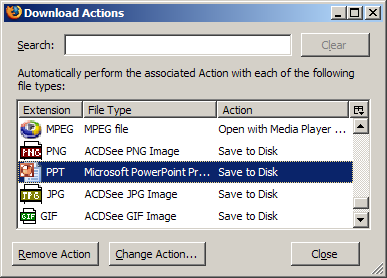
HTML 5 embedding a video
<video src="video.ogv" width="425" height="350"></video>
- it'll also be easy to manipulate (play/pause/stop/etc.) the video via the JS DOM
- one drawback: drama over codecs such as MPEG 4 / H.264, Ogg Theora / VP3, WebM, AVI
Embedded objects: <object>
<object data="video.avi" type="video/avi"></object>
Parameters: <param>
<object id="slider1" width="100" height="50"> <param name="BorderStyle" value="thick" /> <param name="MousePointer" value="hourglass" /> <param name="Enabled" value="true" /> <param name="Min" value="0" /> <param name="Max" value="10" /> </object>
- indicates a parameter to be passed to the embedded object
- required
nameandvalueattributes tell the object what parameter this is and what value it should have
Embedding a YouTube video
<object width="width" height="height" type="application/x-shockwave-flash" data="videoURL"> <param name="wmode" value="transparent" /> parameters </object>
<object width="425" height="350" type="application/x-shockwave-flash" data="http://www.youtube.com/v/eKgPY1adc0A"> <param name="wmode" value="transparent" /> </object>
- this code is HTML5-compliant

 Forms 2.0: sliders, search bars, color/number/email/url/date/time, placeholders, ...
Forms 2.0: sliders, search bars, color/number/email/url/date/time, placeholders, ... 


